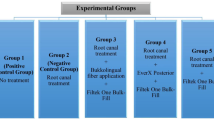Abstract
The aim of this study was to evaluate the morphology of the enamel surface along margins of class V restorations following exposure to cariogenic solution. Restorations were placed in vitro in human third molars. The specimens were divided into groups according to resin composition: (1) Scotchbond 1 + Filtek Flow, (2) Scotchbond 1 + F2000, and (3) Prompt L-Pop + experimental flowable composite. Samples were stored in a demineralizing solution (lactic acid, pH 4.5, 0.1 M) at 37° for 1–4 weeks or in deionized water (control group). The solution was changed every day. Replicas of the specimens were obtained in order to exclude drying artifacts. Scanning electron microscopy (SEM) of original and replica specimens identified a distinct enamel zone, defined as perimarginal enamel showing numerous fractures, porosities, voids, and pits. After the 4-week treatment, perimarginal prismatic enamel was greatly removed, while interprismatic enamel was still in place and only partially dissolved. Enamel not in relation with composite/compomer margins (0.5–1 mm away) showed minor alterations. Perimarginal enamel fractures probably due to composite/compomer shrinkage or the bur preparation may greatly contribute to this marginal enamel demineralization by increasing the number and size of porosities, that enhance the penetration and diffusion of cariogenic solution and create a sort of demineralized enamel subsurface. Only compomer restorations revealed a thin caries inhibition zone (1–2 µm) probably related to fluoride release. Below this protected area, we observed the typical alterations of the other samples. These morphological alterations are probably related to secondary demineralization lesions and may affect the clinical life of restorations.









Similar content being viewed by others
References
Anderson P, Elliot JC (1992) Subsurface demineralization in dental enamel and other permeable solids during acid dissolution. J Dent Res 71:1473–1481
Andersson-Wenckert IE, van Dijken JWV, Horsted P (1998) Interfacial adaptation of in vivo aged polyacid-modified resin composite (compomer) restorations in primary teeth. Clin Oral Invest 2:184–190
Arends J, Christoffersen J (1986) The nature of early caries lesions in enamel. J Dent Res 65:2–11
Chersoni S, Lorenzi R, Ferrieri P, Prati C (1997) Laboratory evaluation of compomers in Class V restorations. Am J Dent 10:147–151
Davidson CL, de Gee AJ, Feilzer A (1984) The competition between the composite-dentin bond strength and the polymerization contraction stress. J Dent Res 63:1396–1399
Fontana M, Dunipace AJ, Gregory RL, Noblitt TW, Li Y, Park KK, Stookey GK (1996) An in vitro microbial for studying secondary caries formation. Caries Res 30:112–118
Haikel Y, Frank RM, Voegel JC (1983) Scanning electron microscopy of the human enamel surface layer of incipient carious lesions. Caries Res 17:1–13
Hickel R, Manhart J (2001) Longevity of restorations in posterior teeth and reasons for failure. J Adhesive Dent 3:45–64
Hubbard MJ (1982) Correlated light and scanning electron microscopy of artificial carious lesions. J Dent Res 61:14–19
Kidd EA, Toffenetti F, Mjor IA (1992) Secondary caries. Int Dent J 42:127–138
Kidd EA, Beighton D (1996) Prediction of secondary caries around tooth-colored restorations: a clinical and microbiological study. J Dent Res 75:1942–1946
Luo Y, Lo ECM, Wei SHY, Tay FR (2002) Comparison of pulse activation vs conventional light-curing on marginal adaptation of a compomer conditioned using a total-etch or a self-etch technique. Dent Mat 18:36–48
Meurman JH, Frank RM (1991) Progression and surface ultrastructure of in vitro caused lesions in human and bovine enamel. Caries Res 25:81–87
Meurman JH, Ten Cate JM (1996) Pathogenesis and modifying factors of dental erosion. Eur J Oral Sci 104:199–206
Palamara D, Palamara JEA, Tyas MJ, Pintado M, Messer HH (2001) Effect of stress on acid dissolution of enamel. Dent Mater 17:109–115
Pearce EIF, Nelson DGA (1989) Microstructural features of carious human enamel imaged with back-scattered electrons. J Dent Res 68:113–118
Prati C, Chersoni S, Cretti L, Mongiorgi R (1997) Marginal morphology of Class V restorations. Am J Dent 10:231–236
Prati C, Saponara Teutonico A, Breschi L, Marchionni S, Savarino L, Mazzotti G (2002) Artificial marginal caries after the use of self-etching and total etching bonding systems. J Dent Res 81:250
Savarino L, Saponara Teutonico A, Breschi L, Prati C (2002) Enamel microhardness after in vitro demineralization and role of different restorative materials. J Biomater Sci Polym Ed 13:329–357
Scott DB, Simmelink JW, Nygaard V (1997) Structural aspects of dental caries. J Dent Res 53:165–178
Shellis RP (1984) Relationship between human enamel structure and the formation of caries-like lesions in vitro. Arch Oral Biol 29:975–981
Xu HHK, Kelly JR, Jahanmir S, Thompson VP, Rekow ED (1997) Enamel subsurface damage due to tooth preparation with diamonds. J Dent Res 76:1698–1706
Acknowledgments
We gratefully acknowledge P. Ferrieri for sample preparation and his assistance with scanning electron microscopy. This study was partially supported by Oriented Fundamental Research and University Research Funds.
Author information
Authors and Affiliations
Corresponding author
Rights and permissions
About this article
Cite this article
Prati, C., Chersoni, S., Suppa, P. et al. Resistance of marginal enamel to acid solubility is influenced by restorative systems: an in vitro scanning electron microscopic study. Clin Oral Invest 7, 86–91 (2003). https://doi.org/10.1007/s00784-003-0207-6
Received:
Accepted:
Published:
Issue Date:
DOI: https://doi.org/10.1007/s00784-003-0207-6




